10 Ways to Say No Without Saying No
Looking for ways to say no without saying no?
In any relationship, there comes a time when you need to express your limits and preferences. It doesn’t matter if it’s a relationship with a friend, a family member, a colleague, or even a stranger.
And that’s what this guide is about. You’ll learn the 10 ways to say No without saying No. As vital as saying “yes” to what resonates with you is the ability to communicate your boundaries gracefully, too.
These strategies will empower you to communicate your preferences, values, and needs effectively in your relationships without screwing things up.
Ready to start setting boundaries while ensuring your relationships remain respectful, compassionate, and enriching? Read till the end.
Different Ways to Say No Without Saying No
In interpersonal relationships, saying ‘no’ without uttering the word itself is a delicate art. The significance lies in preserving connections and fostering understanding.
The psychology behind communication tells us how we convey refusal affects our relationships. That’s why employing strategies like redirecting the conversation, expressing competing priorities, or offering viable alternatives is crucial. They soften the impact of a refusal.
As Maya Angelou aptly put it, “I’ve learned that people will forget what you said, people will forget what you did, but people will never forget how you made them feel.”
Indirect refusals allow you to maintain rapport while leaving a positive imprint in your interactions. Below are the different ways to say No without saying No:
#1: Softening Phrases
Softening phrases are an excellent technique for giving a polite decline without offense. A typical example is this statement,
“I’d love to, but at the moment, my plate is full.”
As you can see, it conveys your appreciation while asserting your boundaries.
Imagine a colleague at work asking you for an additional task. You can reply with a softening phrase like the example above. That way, you pass a respectful refusal while maintaining a positive tone in your workplace.
#2. Suggesting Alternatives
Another subtle way to say No without saying No is suggesting alternatives. It allows you to decline while contributing to problem-solving. So you can use a statement like,
“What if we try this approach instead?”
It gently communicates your refusal while offering a constructive idea. For instance, say a friend invites you to a busy event. You can suggest an alternative, like a quieter gathering.
That way, you show your friend that you’re considerate and open to compromise while maintaining a positive relationship.
How to Say No Without Hurting Someone’s Feelings
Saying ‘no’ without hurting feelings is vital, as studies show people value politeness in refusals. Besides, it’s crucial to consider the other person’s perspective and express empathy.
Tips like using softening phrases and suggesting alternatives can maintain respect while delivering a gentle refusal and nurturing positive relationships.
That said, prioritizing kindness in communication can lead to better understanding and connection.
#3. Active Listening
Active listening is a core strategy for acknowledging someone’s needs while gently refusing. By giving full attention and validating a person’s request, you can say ‘no’ while showing empathy.
For instance, when a friend asks for your help, you can say, “I understand this is important to you, but I can’t assist right now.” This approach shows you respect your friend’s needs.
Also, that allows you to maintain a considerate connection with your friend even though you declined his request.
#4. Empathetic Language
Empathetic language fosters understanding by acknowledging another’s feelings. Phrases like “I can see how you feel” show empathy even when refusing a request.
For instance, if a coworker needs your help on a busy day, you can respond with empathetic language, “I can see this is urgent, but my schedule is tight.”
Such an expression helps you maintain a compassionate connection with coworkers while declining.
5 Ways of Saying No to Someone
There are various ways to say ‘no’ without using the word directly. For instance, you can gently decline a social invitation by using a statement like this:
“I’d love to, but I have a full schedule.”
In a work setting, you can say, “I’m currently working on another project,” to convey your inability to take on more tasks. Of course, these approaches allow you to give polite refusals in different situations while maintaining positive relationships.
#5. The Diplomatic Decline
The diplomatic decline involves gracefully refusing a request. Phrases like “I’d want to, but my current workload doesn’t permit it” showcase this approach.
In a work setting, if asked to take on an extra project, responding with a diplomatic decline shows respect. It also maintains a positive atmosphere.
But the fascinating thing is that despite the refusal, you maintain effective communication and preserve your relationships.
#6. The Appreciative Decline
The appreciative decline involves expressing gratitude while refusing a request. A typical example is making a statement like this:
“I’m grateful for your offer, but my commitments won’t allow me to take part,” softens the impact of the refusal.
Imagine responding this way to a friend who invited you to an event. It shows you appreciate the invitation despite your inability to attend and foster positive relationships.
#7. The Time-Barrier Decline
This is a strategy of saying no without saying no, involving you capitalizing on time as a reason for refusal.
For instance, saying, “I can’t commit to that at the moment, but let’s revisit this in the future,” allows for a gentle refusal. But it leaves the door open for potential collaboration.
In a work context, when asked to take on an extra project, this approach conveys interest in future opportunities.
#8. The Polite Deferral
The polite deferral allows you to postpone a decision without immediate rejection. Using phrases such as, “Let me check my schedule and get back to you,” provides time to assess the request.
Imagine a scenario where someone asks you to attend an event. By adopting this approach, you show consideration and keep the conversation open for a more thoughtful response. More essentially, you maintain positive interactions.
#9. The Boundary-Setting Response
Another strategy of saying no without saying no is the boundary-setting response. It allows you to maintain personal boundaries as you assertively communicate your limits.
A typical example is the phrase below:
“I need to focus on my own needs at the moment.”
A practical scenario is when a friend asks for your time when you need self-care. In this case, more often than not, this approach comes in handy.
That’s because it ensures your needs are respected and promotes healthy relationships founded on mutual understanding and respect.
How to Say No in a Smart Way
In professional settings, saying ‘no’ in a smart way is vital. It involves clear and respectful communication to maintain relationships.
Warren Buffett once said, “The difference between successful people and very successful people is that very successful people say ‘no’ to almost everything.”
Smart refusals involve these while fostering productive connections:
- Prioritizing tasks,
- offering alternatives, and e
- ensuring your boundaries are understood
#10. Using Professional Language
Professional language is crucial for effectively respectfully conveying refusal. Typical examples of these phrases that demonstrate politeness and professionalism include:
“I regret that I can’t commit to this at the moment.”
“I appreciate your offer, but I must decline.”
For instance, in a workplace, when a colleague asks you to take on an extra project, you can use this approach. It helps you maintain a positive tone while delivering a clear refusal.
#Bonus point: Expressing Gratitude
Expressing gratitude when refusing a request adds a considerate touch. For instance, if a friend invites you to a party, using a statement like this showcases respect for their invitation:
“I appreciate the invitation, but I have a prior commitment that day.”
You see, this approach preserves friendships and shows that you value the connection despite your inability to attend the event. As a result, this fosters and maintains a positive relationship with the person in question.
Final Thoughts
We’ve discussed different ways of saying no without saying no that help you improve communication while fostering healthier relationships.
Indeed, these 10 ways to politely decline without using the word ‘no’ focus on empathy, courtesy, and professionalism. From softening phrases to active listening, these strategies assist you in navigating through challenging conversations.
That said, practicing these methods can help you refine your communication skills. Not only that, it can help you strike a harmonious balance between personal boundaries and interpersonal connections.
Ready to start maintaining meaningful interactions in your life?



![How to Get Rid of Smartphone Addiction [Six Practical Ways for ALL]](https://greatcrackers.com/wp-content/uploads/2022/04/Smartphone-addiction.jpg)




